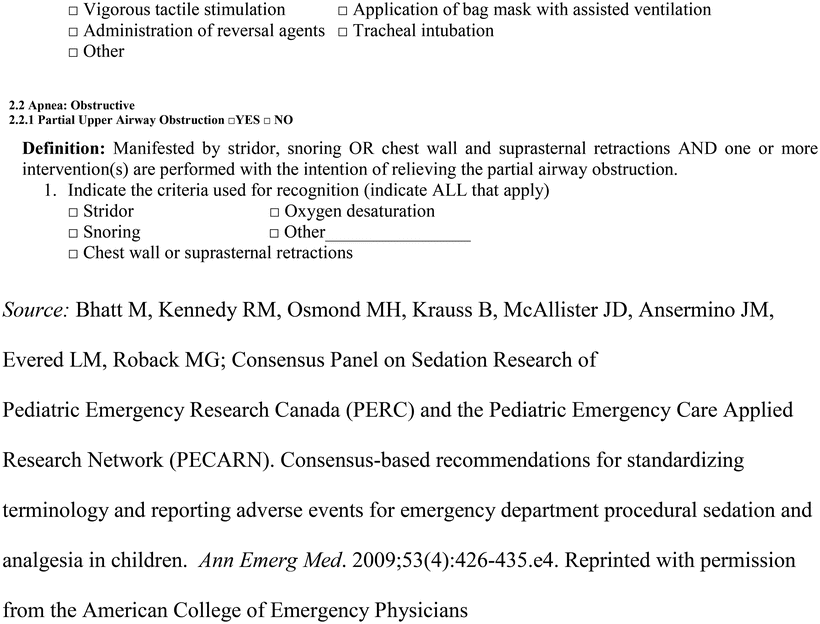Adverse events
Interventions performed in response
1. Oxygen desaturation
• Vigorous tactile stimulation
• Airway repositioning
• Suctioning
• Oral or nasal airway placement
2. Apnea: central versus obstructive (partial versus complete)
• Administration of reversal agents
• Supplementing/increasing oxygen
• Application of positive pressure ± ventilation with bag mask
• Tracheal Intubation
3. Clinically apparent pulmonary aspiration
• Extended observation or admission to hospital
4. Retching/vomiting
• Administration of antiemetic
5. Cardiovascular events
• Chest compressions
Bradycardia
• Administration of medications
Hypotension
• IV fluid administration
6. Excitatory movements
• Procedure was delayed, interrupted, or not completed
7. Paradoxical response to sedation
• Administration of reversal agents
Unpleasant recovery reactions
• Administration of sedation drugs
• Allocation of additional personnel to care for the patient
• Delay in discharge or disposition
8. Permanent complications (neurologic injury or death)
The Quebec Guidelines were intended to provide researchers with a template on which adverse events may be consistently documented and reported with the purpose of consistently collecting data that will allow uniform data sets and meaningful comparisons of sedation studies. Although the guidelines were developed for use in children receiving sedation in the emergency department, an accompanying editorial states that the Quebec Guidelines are broadly applicable to all forms of sedation research or adverse event monitoring [80]. More directly, despite the pediatric intent, each definition and recommendation applies readily to adults. This approach and the principles put forth also extrapolate to any setting in which sedation is performed with appropriate personnel and monitoring [22, 23, 80].
Once data is generated from multicenter studies of large populations of patients using standardized definitions and reporting schemes, meaningful adverse event rates may be established and definitive clinical care guidelines may be devised that will improve our ability to ensure the safety of sedation provided to children outside of the operating room.
Multicenter Investigations
Until just recently no studies of sufficiently large numbers of children who received sedation outside the operating room existed to allow for evaluation of acceptable rates of adverse events. The Pediatric Sedation Research Consortium (PSRC) has published an observational study of more than 30,000 children who received sedation at 26 institutions for mostly elective procedures (8 % emergency), performed by different providers (pediatric intensivists 28.4 %, emergency physicians 27.9 %, and anesthesiologists 19.2 %) using mostly the following drugs singly or in combination: propofol (50.1 %), midazolam (27.1 %), ketamine (13.6 %), or chloral hydrate (11.7 %) [1]. In this large cohort of children, they observed zero deaths, 1 cardiac arrest, 1 case of pulmonary aspiration, 13 episodes of laryngospasm, and 73 patients experienced unexpected apnea. All patients were successfully rescued from potentially adverse outcomes, and 1 in 1,500 sedation events resulted in unexpected admission to the hospital.
A subsequent study examined propofol administration under circumstances similar to their first study in almost 50,000 children [2]. Again, no deaths were observed; however, apnea or airway obstruction was common (5.75 %) and cardiac arrest (n = 2), pulmonary aspiration (n = 4), and laryngospasm (n = 96) occurred. The authors emphasized that safety depends on the providers’ ability to identify potentially serious adverse events, usually respiratory in nature, and provide appropriate rescue. Further data is needed to identify specific patients who may be at an increased risk for adverse events and to establish rates of adverse events in the emergency setting and in those receiving sedation drugs other than propofol.
In 2011, the PSRC published a comparison of major complication rates by provider for 131,751 pediatric procedural sedation cases [5]. Aspiration, death, cardiac arrest, unplanned admission to the hospital, increase in patient’s level of care, and requirement for emergency anesthesia consultation were considered major complications and occurred between 7.6 and 12.4 per 10,000 for anesthesiologists, emergency physicians, intensivists, pediatricians, and other pediatric providers. Given the large sample size, these complication rates may be considered benchmarks for large, elective sedation services staffed by highly trained sedation providers primarily administering propofol.
Ketamine has become the most commonly administered drug for the sedation of children in the emergency department [22, 23, 45, 46, 48, 81–83]. A recent individual patient data meta-analysis of more than 8,000 ketamine administrations to children in 32 emergency departments sheds some light on adverse event rates and risk factors for emergency sedation with ketamine. Green et al. reported an overall incidence of airway and respiratory adverse events of 3.9 % [81]. Clinically apparent pulmonary aspiration did not occur in any of these patients. From this fact we can infer that the rate of aspiration associated with emergency department administered ketamine is very low, but we must consider what the risk actually may be. As illustrated in a JAMA article “If nothing goes wrong is everything alright?,” we need to be cautious about reporting rates of rare adverse events and consider the maximum risk of occurrence [84]. Although this study represents the largest sample of children receiving emergency department ketamine sedation to date and provides important information, larger studies are required to definitively determine the maximal risk for rare adverse events such as aspiration.
Prospective studies of large cohorts of children, using standardized definitions and reporting structures for adverse events are required to generate the data needed to examine carefully the multitude of factors that contribute to adverse events before meaningful “acceptable” adverse event rates may be established.
Future Directions
As described previously, the work of the Pediatric Sedation Research Consortium and the ketamine individual patient data meta-analysis are important first steps toward generating the data required to carefully assess sedation practice in children outside the OR [1, 2, 81]. Recently, the World Society of Intravenous Anesthesia (World SIVA) established an International Sedation Task Force (ISTF) represented by 25 members from multispecialties, both adult and pediatric, from 11 countries. In a recently published manuscript, the ISTF has proposed an Adverse Event Reporting Tool designed to standardize the collection of sedation outcome data worldwide (Table 28.2) [85]. This tool will be an open-access web-based tool, available to providers globally.1 The data collected will be available to individual and institutional users and will, in addition, populate the global ISTF sedation database. The collection of large data from multi-specialists globally will be an important first step to identify and carefully evaluate the range of variables that affect sedation-related adverse event rates. Such studies must be broad reaching in scope yet flexible enough to consider new developments in sedation techniques and monitoring as well as the use of the ever-emerging new sedation drugs that become available.
Table 28.2
International Sedation Task Force Adverse Event Sedation Reporting Tool (www.AESedationReporting.com)
World SIVA adverse sedation event recording tool configured for a web page or paper form | ||||
|---|---|---|---|---|
Step 1: Was there one or more adverse events associated with this sedation encounter? | ||||
• No, this form is now complete | • Yes, fill out remainder of form below | |||
Step 2: Please DESCRIBE the adverse event(s). Check all that apply | ||||
Minimal risk descriptors | Minor risk descriptors | Sentinel risk descriptors | ||
• Vomiting/retching | • Oxygen desaturation (75–90 %) for <60 s | • Oxygen desaturation, severe | • Other specify below | |
• Subclinical respiratory depressiona | • Apnea, not prolonged | (<75 % at any time) or prolonged | ||
• Muscle rigidity, myoclonus | • Airway obstruction | (<90 % for >60 s) | ||
• Hypersalivation | • Failed sedatione | • Apnea, prolonged (>60 s) | ||
• Paradoxical responseb | • Allergic reaction without anaphylaxis | • Cardiovascular collapse/shockg | ||
• Recovery agitationc | • Bradycardiaf | • Cardiac arrest/absent pulse | ||
• Prolonged recoveryd | • Tachycardiaf | |||
• Hypotension f | ||||
• Hypertensionf | ||||
• Seizure | ||||
Step 3: Please note the INTERVENTIONS performed to treat the adverse events(s). Check all that apply | ||||
Minimal risk | Minor risk | Moderate risk | Sentinel intervention | |
• No intervention performed | • Airway repositioning | • Bag valve mask-assisted ventilation | • Chest compressions | • Other, specify below |
Administration of: | • Tectile stimulation or the administration of: | • Laryngeal mask airway | • Tracheal intubation or the administration of: | |
• Additional sedative (s) | • Supplemental oxygen, new or increased | • Oral/nasal airway | • Neuromuscular blockade | |
• Antiemetic | • Antisialagogue | • CPAP or the administration of: | • Pressor/epinephrine | |
• Antihistamine | • Reversal agents | • Atropine to treat bradycardia | ||
• Rapid IV fluids | ||||
• Anti convulsant IV | ||||
Step 4: Please note the OUTCOME of the adverse event(s). Check all that apply | ||||
Minimal risk outcome | Moderate risk outcome | Sentinel outcome | • Other specify below | |
• No adverse outcome | • Unplanned hospitalization or escalation of careh | • Death | ||
• Permanent neurological deficit | ||||
• Pulmonary aspiration syndromei | ||||
Step 5: Assign a SEVERITY rating to the adverse event(s) associated with this sedation encounter | ||||
• It there are any options checked in the Sentinel columns above, then this is a Sentinel j adverse event | ||||
• If the most serious option(s) checked above are Moderate risk, then this is a Moderate k risk adverse event | ||||
• If the most serious option(s) checked above are Minor risk, then this is a Minor l risk adverse event | ||||
• If the most serious option(s) checked above are Minimal risk, then this is a Minimal m risk adverse event | ||||
Only through rigorous adherence to the use of standardized adverse events definitions and reporting structures, such as described in the Quebec Guidelines and by the ISTF, will standardized data sets be compiled. This will allow for the aggregation of data and meaningful comparisons of sedation studies. National and international multispecialty collaborations will be required to develop databases with sufficient patient numbers and the clinical data required to develop and evaluate sedation practice based on patient populations and providers, procedures performed, and drugs administered. The feasibility of such a collaborative endeavor requires not only cooperation of multiple specialties using cutting-edge data collection technology but also a level of funding that to date has not been realized.
Conclusion
From the discussion presented here we can conclude that adverse event rates will vary depending on individual patient characteristics, procedures performed, sedation drugs and doses employed, and the setting in which patients receive care. In addition, the definitions used to identify adverse events and existing reporting structures will also impact on rates of adverse events observed.
A large sedation research consortium has provided us with initial data regarding expected rates of major complications of elective sedation performed by specialized sedation services [5]. As further studies of large numbers of children are performed using standardized definitions and reporting of adverse events, we will gain a clearer picture of what may be expected and acceptable adverse event rates for sedation performed outside the OR. Further multicenter, prospective research of international populations of children who receive sedation to identify risk factors for adverse events is needed so that true evidence-based sedation best practice guidelines may be established.
Standards of adverse event rates will vary based on the characteristics of the sedation experience as described previously. However, patient safety will ultimately be ensured by the careful assessment of risks and benefits of sedation that is performed in carefully monitored and controlled settings by skilled providers prepared to provide cardiorespiratory rescue when needed.
Appendix: Recommended Documentation for Sedation Research


References
1.
Cravero JP, Blike GT, Beach ML, et al. Incidence and nature of adverse events during pediatric sedation/anesthesia for procedures outside the operating room: report from the Pediatric Sedation Research Consortium. Pediatrics. 2006;118(3):1087–96.PubMedCrossRef
Stay updated, free articles. Join our Telegram channel

Full access? Get Clinical Tree


